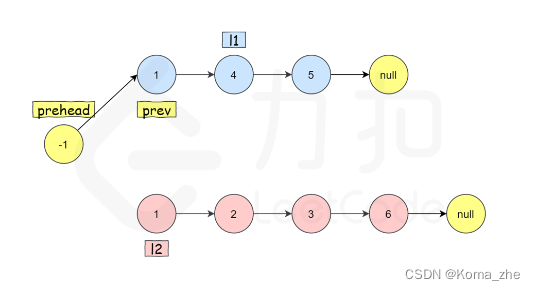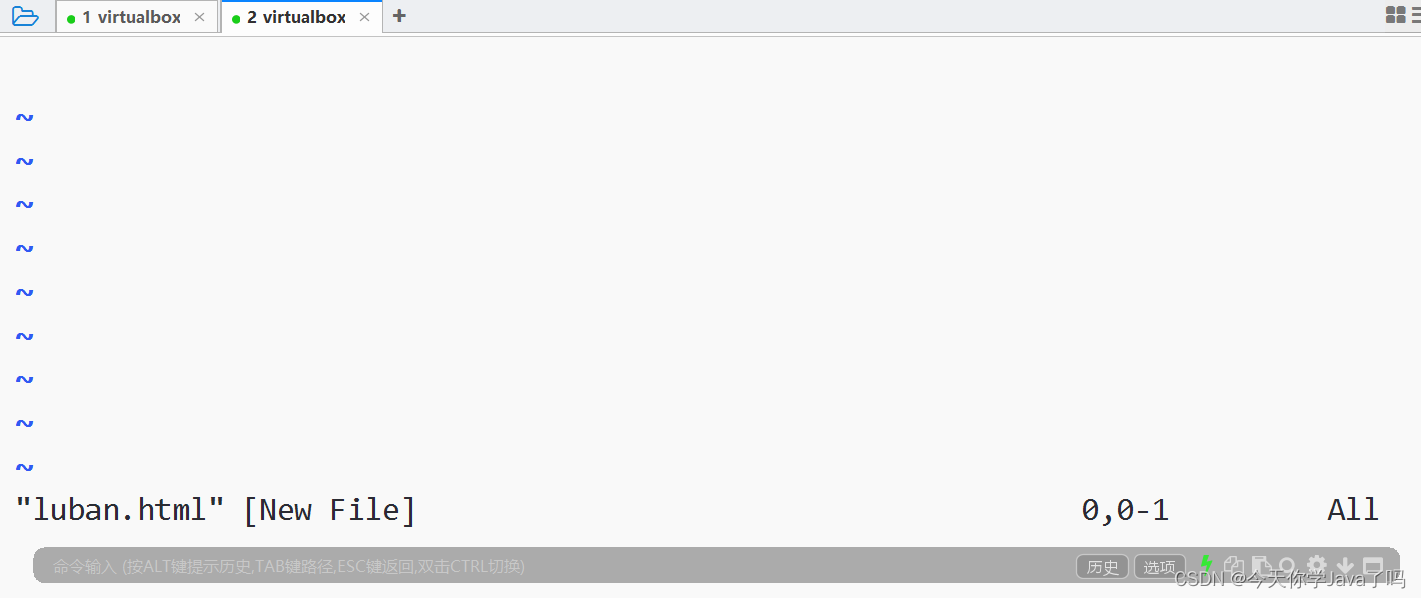作业一:打开两个终端,要求实现AB进程对话【两根管道】
打开两个终端,要求实现AB进程对话
- A进程先发送一句话给B进程,B进程接收后打印
- B进程再回复一句话给A进程,A进程接收后打印
- 重复1.2步骤,当收到quit后,要结束AB进程
- 提示:两根管道
A终端代码
#include <stdio.h>
#include <sys/types.h>
#include <sys/stat.h>
#include <errno.h>
#include <fcntl.h>
#include <unistd.h>
#include <string.h>/***************************B终端***************************/ int main(int argc, const char *argv[])
{//创建管道1 A终端写入--->管道1--->B终端读取if(mkfifo("./fifo",0664) < 0){if(errno != 17){perror("mkfifo");return -1;}}printf("mkfifo pipe1 success __%d__\n",__LINE__);//创建管道2 B终端写入--->管道2--->A终端读取if(mkfifo("./myfifo",0664) < 0){if(errno != 17){perror("mkfifo");return -1;}}printf("mkfifo pipe2 success __%d__\n",__LINE__);//以读的方式打开管道1int fd_r=open("./fifo",O_RDONLY);if(fd_r < 0){perror("open");return -1;}printf("open pipe1 success __%d__\n",__LINE__);//以写的方式打开管道2int fd_w=open("./myfifo",O_WRONLY);if(fd_w < 0){perror("open");return -1;}printf("open pipe2 success __%d__\n",__LINE__);char buf[128]="";ssize_t res = 0;int c=-1;while(1){//管道1操作(读取数据)bzero(buf,sizeof(buf));res=read(fd_r,buf,sizeof(buf));c=strcmp(buf,"quit");//判断B终端输入的是否是quitif(0 == c){break;//是quit则退出进程}if(res < 0){perror("read");return -1;}if(0 == res ){printf("对方进程退出\n");break;}printf("A:%s\n",buf);//管道2操作(写入数据)printf("请输入>>> ");fgets(buf,sizeof(buf),stdin);buf[strlen(buf)-1] = '\0';if((write(fd_w,buf,sizeof(buf))) < 0){perror("write");return -1;}//当管道2关闭,管道2的写段尝试写入数据,则管道破裂,退出进程}close(fd_r);close(fd_w);return 0;
}B终端代码
#include <stdio.h>
#include <sys/types.h>
#include <sys/stat.h>
#include <errno.h>
#include <fcntl.h>
#include <unistd.h>
#include <string.h>/***************************A终端***************************/int main(int argc, const char *argv[])
{//创建管道1 A终端写入--->管道1--->B终端读取if(mkfifo("./fifo",0664) < 0){if(errno != 17)//如果错误是已有管道,则跳过,可正常运行{perror("mkfifo");return -1;}}printf("mkfifo pipe1 success __%d__\n",__LINE__);//创建管道2 B终端写入--->管道2--->A终端读取if(mkfifo("./myfifo",0664) < 0){if(errno != 17){perror("mkfifo");return -1;}}printf("mkfifo pipe2 success __%d__\n",__LINE__);//以写的方式打开管道1int fd_w=open("./fifo",O_WRONLY);if(fd_w < 0){perror("open");return -1;}printf("open pipeA success __%d__\n",__LINE__);//以读的方式打开管道Bint fd_r=open("./myfifo",O_RDONLY);if(fd_r < 0){perror("open");return -1;}printf("open pipeB success __%d__\n",__LINE__);char buf[128]="";ssize_t res = 0;int c=-1;while(1){//管道1操作(写入数据)printf("请输入要对B说的话>>> ");fgets(buf,sizeof(buf),stdin); //从终端获取数据buf[strlen(buf)-1] = '\0'; //将\n改成\0if((write(fd_w,buf,sizeof(buf))) < 0) //将字符串写进管道A {perror("write");return -1;}//当管道1的读段关闭,管道1的写段尝试写入数据,则管道破裂,退出进程//管道2操作(读取数据)bzero(buf,sizeof(buf));//清空字符串res=read(fd_r,buf,sizeof(buf));//读取B管道中的数据c=strcmp(buf,"quit");//将读到的数据与quit比较if(0 == c)//如果相同,c为0,达到退出条件,可以退出循环{break;}//printf("写入数据成功 res=%ld\n",res);if(res < 0)//read函数执行失败,返回负数{perror("read");return -1;} if(0 == res)//read执行成功,但读到了0个数据`{printf("对方进程退出\n");break;}//打印从管道2中读取到的数据printf("B:%s\n",buf);}//关闭管道1、管道2close(fd_r);close(fd_w);return 0;
}A终端结果
ubuntu@ubuntu:02_fifo$ gcc 03_pipe_w.c -o w
ubuntu@ubuntu:02_fifo$ ./w
mkfifo pipe1 success __22__
mkfifo pipe2 success __33__
open pipeA success __42__
open pipeB success __50__
请输入要对B说的话>>> 你好,我是A
B:你好呀,我是B
请输入要对B说的话>>> 你吃饭了吗?
B:吃了,你呢
请输入要对B说的话>>> 不告诉你
ubuntu@ubuntu:02_fifo$ B终端结果
ubuntu@ubuntu:02_fifo$ gcc 02_pipe_r.c -o r
ubuntu@ubuntu:02_fifo$ ./r
mkfifo pipe1 success __22__
mkfifo pipe2 success __33__
open pipe1 success __42__
open pipe2 success __50__
A:你好,我是A
请输入>>> 你好呀,我是B
A:你吃饭了吗?
请输入>>> 吃了,你呢
A:不告诉你
请输入>>> quit
对方进程退出
ubuntu@ubuntu:02_fifo$

作业二:在作业一的基础上,AB能随时发信息给对方(全双工)
此代码无法quit结束对话
A终端代码
#include <stdio.h>
#include <stdlib.h>
#include <sys/types.h>
#include <sys/stat.h>
#include <errno.h>
#include <fcntl.h>
#include <unistd.h>
#include <string.h>
#include <wait.h>/***************************A终端***************************/int main(int argc, const char *argv[])
{umask(0);//创建管道1 A终端写入--->管道1--->B终端读取if(mkfifo("./fifo",0777) < 0){if(errno != 17)//如果错误是已有管道,则跳过,可正常运行{ perror("mkfifo");return -1;}}printf("mkfifo pipe1 success __%d__\n",__LINE__);umask(0);//创建管道2 B终端写入--->管道2--->A终端读取if(mkfifo("./myfifo",0664) < 0){if(errno != 17){perror("mkfifo");return -1;}}printf("mkfifo pipe2 success __%d__\n",__LINE__);//创建子进程pid_t cpid=fork();//以写的方式打开管道1int fd_w=open("./fifo",O_WRONLY);if(fd_w < 0){perror("open");return -1;}printf("open pipeA success __%d__\n",__LINE__);//以读的方式打开管道Bint fd_r=open("./myfifo",O_RDONLY);if(fd_r < 0){perror("open");return -1;}printf("open pipeB success __%d__\n",__LINE__);char buf[128]="";ssize_t res = 0;int c=-1;if(0 == cpid)//子进程发送{while(1){//管道1操作(写入数据)fgets(buf,sizeof(buf),stdin); //从终端获取数据buf[strlen(buf)-1] = '\0'; //将\n改成\0if((write(fd_w,buf,sizeof(buf))) < 0) //将字符串写进管道A {perror("write");return -1;}printf("A: %s\n",buf);//当管道1的读段关闭,管道1的写段尝试写入数据,则管道破裂,退出进程//c=strcmp(buf,"quit\n");//将读到的数据与quit比较if(strncmp(buf,"quit",4) == 0)//如果相同,c为0,达到退出条件,可以退出循环{break;}//printf("写入数据成功 res=%ld\n",res);}close(fd_w);exit(0);}else if(cpid > 0)//父进程接收{while(1){//管道2操作(读取数据)bzero(buf,sizeof(buf));//清空字符串res=read(fd_r,buf,sizeof(buf));//读取B管道中的数据if(res < 0)//read函数执行失败,返回负数{perror("read");return -1;}if(0 == res)//read执行成功,但读到了0个数据`{printf("对方进程退出\n");break;}//打印从管道2中读取到的数据printf("B:%s\n",buf);}wait(NULL);close(fd_r);}//关闭管道1、管道2close(fd_r);close(fd_w);return 0;
}
B终端代码
#include <stdio.h>
#include <stdlib.h>
#include <sys/types.h>
#include <sys/stat.h>
#include <errno.h>
#include <fcntl.h>
#include <unistd.h>
#include <string.h>
#include <wait.h>/***************************B终端***************************/int main(int argc, const char *argv[])
{//创建管道1 A终端写入--->管道1--->B终端读取if(mkfifo("./fifo",0777) < 0){if(errno != 17){perror("mkfifo");return -1;}}printf("mkfifo pipe1 success __%d__\n",__LINE__);//创建管道2 B终端写入--->管道2--->A终端读取if(mkfifo("./myfifo",0777) < 0){if(errno != 17){perror("mkfifo");return -1;}}printf("mkfifo pipe2 success __%d__\n",__LINE__);//创建子进程pid_t cpid=fork();//以读的方式打开管道1int fd_r=open("./fifo",O_RDONLY);if(fd_r < 0){perror("open"); return -1;}printf("open pipe1 success __%d__\n",__LINE__);//以写的方式打开管道2int fd_w=open("./myfifo",O_WRONLY);if(fd_w < 0){perror("open");return -1;}printf("open pipe2 success __%d__\n",__LINE__);char buf[128]="";ssize_t res = 0;//int c=-1;if(0 == cpid)//子进程接收{while(1){//管道1操作(读取数据)bzero(buf,sizeof(buf));res=read(fd_r,buf,sizeof(buf));if(res < 0){perror("read");return -1;}if(0 == res ){printf("对方进程退出\n");break;}printf("A:%s\n",buf);}close(fd_r);exit(0);}else if(cpid > 0)//父进程发送{while(1){//管道2操作(写入数据)printf("B: ");fgets(buf,sizeof(buf),stdin);buf[strlen(buf)-1] = '\0';if((write(fd_w,buf,sizeof(buf))) < 0){perror("write");return -1;}//当管道2关闭,管道2的写段尝试写入数据,则管道破裂,退出进程//c=strcmp(buf,"quit");if(strncmp(buf,"quit",4) == 0)//判断B终端输入的是否是quit{break;}}close(fd_w);wait(NULL);}else{perror("fork");return -1;}close(fd_r);close(fd_w);return 0;
}





